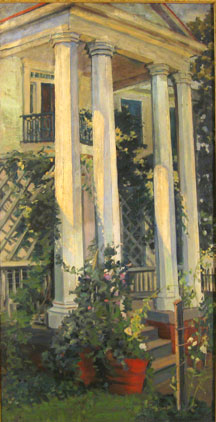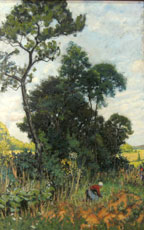At the peak of her career, Kate Freeman Clark gave up painting
Artists sometimes are not recognized to be worthy of talent until after their death. So it is true with Kate Freeman Clark.
Kate had taken art classes in Memphis, and then in 1894 enrolled at the Art Students League in New York under the painter and well-known teacher William Merritt Chase. She spent the following years working with other students of talent at the League. Subsequently, Chase opened his own school and purposed many students from the League to follow him, including Kate. In her own words she described these years as her happiest and most productive.
Kate was one of Chase’s most successful students. She studied with him for six years at his Shinnecock summer art school on Long Island, and then exhibited her work in many places from 1904 to 1914. During those years, she signed her paintings under “Freeman Clark” so art prospects would not judge her skill based on gender. Her art style alternated between dark portraits and light plein-air concept of painting spontaneously on location. En plein aire is a French expression which means "in the open air", and is particularly used to describe the act of painting outdoors. Her style was greatly influenced by her teacher Chase, as well as the people and places of New York City and Long Island. Though she returned to Mississippi on a regular basis to fulfill family obligations, it is probable that she painted only two pictures of a Southern subject.
At left, Work out in Mississippi Grove (Oil on linen, 47 X 29.5, ca. 1900) is an unknown location but was titled by Kate Freeman Clark as being in Mississippi. On the right is The Shuford House (Oil on canvas, 40 X 21, ca. 1900) which undoubtably is a painting of the front of Finley Place located directly behind her home at Walthall Place in Holly Springs. Ironically, Kate Freeman Clark's backyard ajdoined that of Finley Place whose owners donated the house and thousands of acres of farm and woodlands to the Mississippi Audobon Society.
Sadly, in 1924, Kate put away her brushes and stored her paintings in the Lincoln Warehouse, New York. Kate gave up her painting career after experiencing immense sadness from the loss of her teacher Chase in 1916, and then her beloved grandmother and mother in quick sequence. These crushing losses of those closest to her were also joined with a change in artistic style to the risiing popularity of Modern Art.
"The shift away from objective representations of what the eye saw in nature to stylized expressions of what the mind invented was too radical for an artist like Kate Freeman Clark," said Cynthia Grant Tucker in her biography Kate Freeman Clark: A Painter Rediscovered.
This perfect storm of circumstances – both professional and personal – collided within a short period of time to make Kate Freeman Clark conclude that the best course for her would be return to her Holly Springs home, a place of stability, closing the door to a 20-year career.
She never returned to New York; she chose never to paint again. While living in Holly Springs she returned to her Southern culture and exhibited the lifestyle of the proper Southern lady. Kate adapted herself to the social expectations of her day so well that many of her friends were not aware that she had been an accomplished artist during her years in the Northeast. She lived the remainder of her life unmarried.
When Kate died at the age of 81, her neighbors were surprised to learn of her gift of paintings for the enjoyment of the people of Holly Springs. A few friends remembered that she had studied art in the Northeast years before, but few realized how accomplished an artist she had become.
With her will, Kate Freeman Clark bequeathed her home and several hundred canvases and sketches from her New York years to the town of Holly Springs. Along with it she left instructions and funds to build an art museum to house her paintings which were inventoried to include over 1,200 sketches and paintings, some as tall as six feet and as small as a cigar box top.
Today the Kate Freeman Art Gallery is what Kate Freeman Clark wanted: "A museum of fine and social arts."
The paintings she left to Holly Springs are a tribute to her teacher, William Merritt Chase, but the talent and skill belong to her. Kate’s decision not to work again after returning home is a statement about the cultural expectations at a time in our country’s history when women were just beginning to be accepted in the arts.
One interpretation of why she gave up art is given by Kathleen McClain Jenkins in her essay in Mississippi Women: Their Histories, Their Lives.
"Carey Freeman Clark (her mother) died in August 1922, and for the firtst time ever, Kate was left alone. Without her mother's bullying, and without others to plan her life around, Kate Freeman Clark found hereself adrift. Her attempt to revive her painting career had stalled. Times had changed. Tastes had changed. The art world had changed. In despair and confusion she agonized over whether to stay in New York or to give it up for the Walthall home place that was now her own. Old family friends urger her to retreat to the comfort and security of Holly Springs, but her artist friends and former teachers were equally adamant in their contradictory advice.
"The story of Kate Freeman Clark is that of a poor little rich girl, for she seemed in some ways blessed with a fairy-tale life, but one tempered by human tragedy and struggle. She was born in upper echelons of Mississippi society and progressed to similar status in Washington and New York. She partook of the country's best art education in New York and the new summer art colonies on Long Island. She found confirmation of her artistic talent from the greatest painter and the most prestigious exhibition venues of her day. But her father, her best suitor, and her adored mentor each in their turn disappeared unexpectedly from her life. Her strong-willed mother fiercely protected and pushed her, almost to the point of destroying her ability to function on her own. Ironically, it was her little lady grandmother who doggedly held to the Walthall heritage in Holly Springs and maintained a connection that eventually enabled Kate Clark's return to Mississippi. Kate Freeman Clark loved her family and her art, and when she had lost both, she followed the example set by her widowed mother and grandmother before her. She went home."
BIOGRAPHICAL RESOURCES
The Artist's Sketch - A Biography of Painter Kate Freeman Clark by Carolyn J. Brown. Available at Kate Freeman Clark Art Gallery, Marshall county Historical Museum and Amazon.com https://tinyurl.com/2adnmbsd
Kate Freeman Clark: A Painter Rediscovered, Cynthia Grant Tucker, University Press of Mississippi1981Mississippi Women: Their Histories, Their Lives, Vol. 1, Kate Freeman Clark An Artist and A Lady, Kathleen McClain Jenkins, Page 98-112. University of Georgia Press.
"And speaking of which" Kate Freeman Clark, blog by Jim Woodrick.


